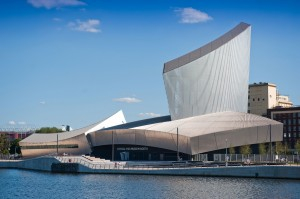 In the first few years of the National Lottery, museums were built employing architects who had no interest in museums per se but instead limitlessly indulged their own vanity. Those who drew attention to the blatant unsuitability of resulting buildings were dissed as old-fashioned, traditional and behind the architectural times. The result of this defended process was that buildings materialised which were uniquely unsuitable. This building-for-appearances sake continues but, following numerous notable failures, sensible scepticism is growing.
In the first few years of the National Lottery, museums were built employing architects who had no interest in museums per se but instead limitlessly indulged their own vanity. Those who drew attention to the blatant unsuitability of resulting buildings were dissed as old-fashioned, traditional and behind the architectural times. The result of this defended process was that buildings materialised which were uniquely unsuitable. This building-for-appearances sake continues but, following numerous notable failures, sensible scepticism is growing.
One might reasonably ask why museum trustees went along with this philosophy in the first place. Surely they should have realised at the time the unsuitability of structures such as the Imperial War Museum North. One supposes the commissioners of such a pisspoor building wanted to be seen as ambitious, forward looking, and willing to embrace the new even if it was fundamentally crass. They did not want to appear cautious or conservative: indeed, it’s a certainty they wouldn’t have been appointed as trustees if they were. And you can bet your pension that the Lottery, with its hand-picked State Art assessors, wouldn’t consider supporting any plan without the cutting-edge novelty added by one of its approved architects. During this process the basic intellectual challenge in any building, that originality of design should be matched to suitability of purpose, was waived.
The Imperial War Museum North is a horrible failure. Twelve years after opening it is already dilapidated and its inadequacies depressingly apparent. Even in warm weather the attendant showing people to a concealed concrete entrance has to be dressed for the Pole because a vortex of cold wind rushes through an ugly, skeletal and empty tower. And so much of this building is also empty. Like many such developments it looks huge and unusual from a distance and cheap, jerry-built and cramped on arrival.
The exhibition space is an asymmetrical, gloomy shed, high roofed and echoing, where it is hard to find bearings. Corridors are poky, meandering and seemingly ad hoc and there are no galleries for showing the pictures of the best collection of 20th century British art outside the Tate.
Gilbert Rogers’s Ypres, 1915 (above), 11 by 15 feet, is being exhibited for the first time in a century. It shows the work of the RAMC and the British Red Cross tending wounded at a dressing station during the first battle of Ypres in 1914. You might have thought they would have exhibited this picture prominently, but instead it is stuck behind a staircase because they can just about wedge it in there, but nowhere else. You can’t see it comfortably. It was worth pulling out of store but they had nowhere to show it properly in a museum they had themselves commissioned. The fact that the IWMN displays, as currently organised, constitute an unordered, noisy ‘Visitor Experience’ of conflicting flashing projections in which every surface is ripe for films and animations is another serious problem. The place has more in common with a multiplex than a museum.
With the IWM’s London headquarters unluckily closed for the first half of this WW1 centenary year, how easy it ought to have been to truck up to this outpost some of the great First World War pictures currently not on show. But there isn’t anywhere to put them. Indeed, the exhibition area is tiny compared to the overall dimensions of the site and the outer bluster of the structure.
How did the trustees fall for this turkey of a stunt without asking obvious questions about its unsuitability? Doubtless they were intimidated by architect Daniel Liebeskind spinning them a line about the globe being shattered and the pieces being reconstructed in a way which would “emotionally move the soul of the visitor toward a sometimes unexpected realization”. That’s the sort of bollocks mouthed by the desperate in all professions. The fact is the trustees were sold a pup by a silvertongue. Thus was a worthwhile project sacrificed to the whim of an architect whose one London building on Holloway Road is the capital’s tackiest eyesore.
We inhabit an age when it is impossible to expect a new museum capable of showing exhibits well. Why has it become impertinent to demand a building fitted to its purpose?
David Lee


